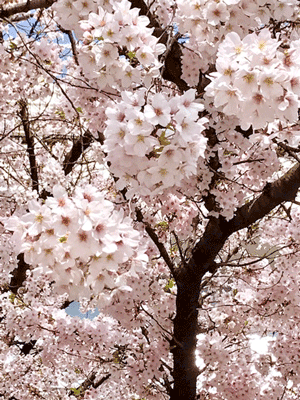News
April - Hanami Updated in April 2018
Since when did sakura or cherry blossoms become so popular in Japan? Our team took a glimpse into the history of “hanami” customs in Japan. “Hana” means flower and “mi” means to view. According to a column by a florist, hanami used to mean the viewing of plum flowers, which bloom earlier than sakura. Due to its fragrant aroma, plum or ume flowers were considered to be more exquisite than sakura before 9-10th century. Farmers on the other hand, observed the blooming of sakura very carefully to calculate the best days for rice planting. After Japan stopped sending envoys to China’s Tang Dynasty, distinct Japanese culture started to develop around 10th century including the appreciation of sakura. Later on, large-scale hanami became immensely popular among the samurai or bushi class. Because warlords of 16th century preferred sakura, many temples and shrines started to plant sakura trees in their gardens. After the Tokugawa family started to provide hanami spots for common people during the Edo period (17th-mid 19th century), sakura-viewing became a national pastime. Sakura and chrysanthemum are both national flowers of Japan.

-
Goryokaku (Hokkaido)
Time: Late April - Early May
Place: Goryokaku
Address: 44-3 Goryokakucho, Hakodate-shi, Hokkaido
Access: 10-minute walk from Goryokaku Koen-mae station on Hakodate-shi city tramhttps://jw-webmagazine.com/star-shaped-cherry-blossoms-fort-goryokaku-5da74450c2ee/
https://www.hakobura.jp/ Hirosaki Cherry Blossom Festival (Aomori)
Time: Mid April - Early May
Place: Hirosaki Koen park
Address: 1 Shimoshirogane-cho, Hirosaki-shi, Aomori-ken
Access: The park is a 20-minute walk or 10-minute bus ride from JR Hirosaki station-
Fuji Shibazakura Festival
A festival that features dark-colored sakura:
Time: April 14 - May 27
Place: Fuji Motosu-ko (Lake) Resort
Address: 212 Motosu, Fujikawaguchiko-machi, Minamitsuru-gun, Yamanashi-ken
Access: 30-minute ride on Shibazakura Liner bus from JR Kawaguchiko station Ogaki Funakudari (Gifu)
A boat ride to view sakura:
Time: March 31-April 15
Place: Suimon-gawa River boat pier
Address: Takasago-cho, Ogaki-shi, Gifu-ken
Access: 7-minute walk from JR Ogaki stationhttps://visitgifu.com/see-do/all/
http://www.fuji-travel-guide.com/news-item/2017-boat-river-cruise-in-ogaki-city-in-gifu-prefecture/
http://www.ogakikanko.jp/event/fune/tirasi01.pdf
-
Hana-Matsuri (Saga)
A flower festival held at a nationally registered memorial site:
Time: March 16-April 8
Place: Mifuneyama Rakuen Park
Address: 4100 Takeo, Takeo-cho, Takeo-shi, Saga-ken
Access: 5-minute bus ride from JR Takeo Onsen station; get off at Mifuneyama Rakuen bus stophttps://www.mifuneyamarakuen.jp/early_spring/
https://www.facebook.com/mifuneyamarakuen







